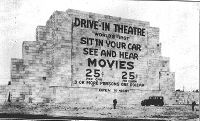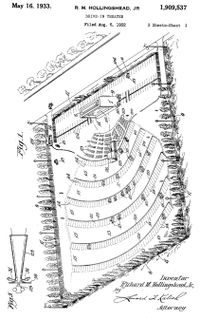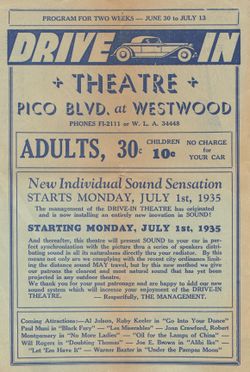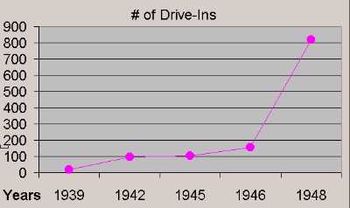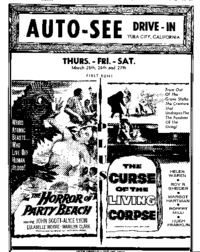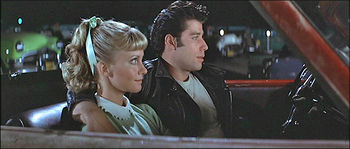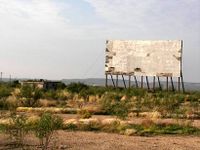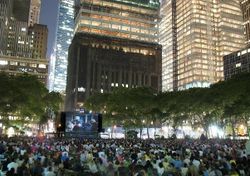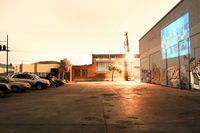Drive-In Theater
Popular during the mid 20th century, a drive-in is an outdoor movie theater venue in which people sit with their cars parked in front of a screen to watch films.
Contents
Origins and History
Richard M. Hollingshead
The concept of the drive-in is an invention of Richard Hollingshead Jr., a native of Riverton, New Jersey. According to legend, Hollingshead’s mother was too heavy-set to comfortably fit in the seats at traditional movie theaters, and her well-meaning son wanted to find a way to accommodate her. Since Hollingshead had worked for his father’s autoparts business, he knew a fair amount about automobiles, or at least enough to spark a novel idea. Hollingshead engineered a homemade exhibition set up comprised of a sheet nailed to his garage door, a Kodak projector on top of his car, and an FM transmitter. Although primitive, it worked, and thus the concept of the drive-in was born. On May 16th of 1933, Hollingshead applied to receive a patent for his invention.
"My invention relates to a new and useful outdoor theater and it relates more particularly to a novel construction in outdoor theaters whereby the transportation facilities to and from the theater are made to constitute an element of the seating facilities of the theater...wherein the performance, such as a motion picture show or the like, may be seen and heard from a series of automobiles so arranged in relation to the stage or the screen, that the successive cars behind each other will not obstruct the view. " - Richard M. Hollingshead, in his patent application submitted on August 6, 1932. (Segrave 1)
The Golden Age of the Passion Pit
Hollingshead's request was quickly acquiesced. From there, he went on to open the first official drive-in movie theater in Camden, New Jersey within the same year. It was an immediate success and the concept began to spread slowly across the country.. In the next six years, 18 drive-ins were built across the country from Maine to California.
First 15 Drive-in Theaters built in the U.S.
1. Drive-In Theatre: Camden, New Jersey. June 6, 1933
2. Shankweiler's Auto Park: Orefield, Pennsylvania. April 15, 1934
3. Drive-In Short Reel Theater: Galveston, Texas. July 5, 1934
4. Pico: Los Angeles, California. September 9, 1934
5. Weymouth Drive-In Theatre: Weymouth, Massachusetts. May 6 1936
6. Starlight Auto Theatre: Akron, Ohio. Summer, 1937
7. Lynn Open Air Theater: Lynn, Massachusetts. July, 1937
8. Providence: Providence, Rhode Island. July 21, 1937
9. Miami Drive-In: Miami, Florida. February 25, 1938
10. Detroit Drive-In: Detroit, Michigan. June 2, 1938
11. Cleveland: Cleveland, Ohio. June, 1938
12. Shrewsbury Drive-In: Shrewsbury, Massachusetts. June, 1938
13. San-Val: Burbandk, California. June 10, 1938
14. Merrimack Auto Theatre: Methuen, Massachusetts. Summer, 1938
15. Valley Stream: Long Island, New York. August 10, 1938 (Segrave 11-21)
Just three years later, that number had grown to 95. So by 1942, although the roadside theaters were more popular than ever, the United State's entrance into World War II after Pearl Harbor sent the drive-in boom into a temporary remission. Only six theaters were built during the years 1942-1945. Populations in the rural areas were down, people were conserving, and supply rationing meant that securing the supplies necessary to either build or run a drive-in was more difficult than ever. Many of the theaters shut down for one or two years to weather the storm until the war was over. But by 1946, production was booming again and the number of theaters had risen dramatically, to 155, then by 1948 that number had quintupled and there were more than 800 operational drive-in's in the U.S. The theaters played a significant role in helping rebuild the post-war economy of the country. Not only that, the drive-in became a haven for families looking to reconnect and rebuild as well.
The Baby Boom: Family Time at the Movies
The drive-in was a mechanism for post World War II rebuilding of the American nuclear family. It was a wholesome locale where dad, mom, child #1 and child #2 could go and spend time together, bonding, but without too much actual interaction. The concept of the suburb is interesting because of its paradoxical components. Originally, people moved to the burbs for privacy, and to get the space that wasn’t available to them in the cities. But historically, suburbs have become hubs for community interaction. Ironically, people wanted to live their private lives, together with other people doing the same. The drive-in became analogous with that concept. The theaters allowed people to maintain a sense of security and anonymity, because they remained in the privacy of their own vehicle, but they had company of hundreds of other cars, also filled with people doing the same thing.
Design and Logistics
The drive-in can be classified as a specific type of architecture: roadside architecture. Along with things like motels, truck stops, and gas stations, drive-in structures were built efficiently with little to no frills to minimize cost and maximize profit. “As a whole, roadside architecture has had a tremendous impact on the American landscape, especially evident in the array of forms, images, and colors that comprise the panoramic view from our windshields.” And their designs were so simple that building them cheaply wasn’t hard to do. There are four primary components to most theaters: the screen, the projector, the sound dissemination device and/or technique, and the viewing area. The screen could be anything from a white sheet to a professional grade, synthetic piece designed specifically for the drive-in. Concession stands were one other aspect that was a fixture at most theater. But as aforementioned, anything extra, like decoration or design elements, were added to increase profits. For instance, if a drive in’s sign featured an elaborate painting and lighting set-up, the only reason was so people on the highway would see it and exit to come check it out. (Bell)
Drive-In Theaters on Film
Hundreds of films have scenes that feature drive-in movie theaters: American Graffiti, Lolita, Midnight Cowboy, Red Dawn, Jawbreaker, Hope Floats, Never Been Kissed, Death Proof, Cider House Rules, Back to the Future III, and many more. A good list can be found at http://www.michigandriveins.com/movies.asp. The 1978 film Grease is one of the most famous movies to prominently feature its characters going to a drive-in. Although filmed in the late 70's, the story is set in California during the late 50's. This was the era of the sock-hop, jukebox, and the drive-in. The scenes in Grease were filmed at an actual drive-in, the Pickwick Drive-In Theater, located in southern California in Burbank. Sadly, not even this iconic theater could survive the onslaught of the 'big box stores', like Target or Bed Bath and Beyond, whose proliferation has led to the tearing down of countless structures to make way for their personalized strip centers. In 1989 the Pickwick was torn down to make way for a Staples office supply store. (Lozano)
Megaplexes and the Downfall of Drive-In's
With the advent of the megaplex, the drive-in suffered. They flashy new centers housing 8, 10, 12, and sometimes 16 movie screens began drawing crowds by the droves. All of the issues that a patron might have dealt with at the drive in, sound quality, weather, distance from the screen, were erased with the megaplex.
Commodifying Nostaligia: Theaters Today
One of the reasons thought to have contributed to the great success of drive ins in the mid 20th century was the fact that it merged two of the most prolific inventions of the era: the automobile and the motion picture. But ironically, that concept might have contributed to the waning interest in the theaters in the 21st century. Neither the car nor the motion picture are models of technological advancement anymore and people's attentions are focused on newer and better things . And since the novelty for both films and cars has long since worn off, the novelty of an invention that combined both of those would also have worn off. A few hundred drive-in movie theaters that still exist today collectively serve to help people understand America’s cultural heritage. They are symbol for the golden ages of the 1950’s and 60’s in America. Although more and more of the theaters close down every year, their legacy is etched into the history books of America. No matter how small in numbers, drive-in’s will always remain an important piece of Americana. Today, the tradition of "movies in the park" can be seen as a modern day reincarnation of the drive-in feel. Especially in big cities like New York where a drive-in theater would not be logistically possible, movies in places like Central Park and Bryant Park help give citizens that community viewing experiences that the drive-in's became famous for.
Guerilla Drive- In's
Another way drive-in's continue to live on is through the estalishment of "guerilla drive in's. This is a practice where people set up make shift drive-in theaters in temporary locations to screen just one movie. The sides of warehouses,
Links
http://www.liketelevision.com/liketelevision/tuner.php?channel=158&format=tv&theme=hollywood
http://www.guerilladrivein.org/
Bibliography
Bell, Shannon. "FROM TICKET BOOTH TO SCREEN TOWER AN ARCHITECTURAL STUDY OF DRIVE-IN THEATERS IN THE BALTIMORE-WASHINGTON, D.C.-RICHMOND CORRIDOR." Perspectives in Vernacular Architecture. 2003: Print.
Lozano, Carlos. "Death of a Drive-In." Los Angeles Times 08 Oct. 1989, Print.
Sanders, Don, and Susan Sanders. American Drive-in Movie Theater . 2nd ed. St. Paul, MN: MBI Publishing Company, 2003. 8-157. Print.
Segrave, Kerry. Drive-in theaters: a history from their inception in 1933. Jefferson, NC: McFarland and Company, Inc., 1992. 1-200. Print.
